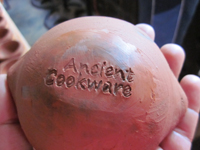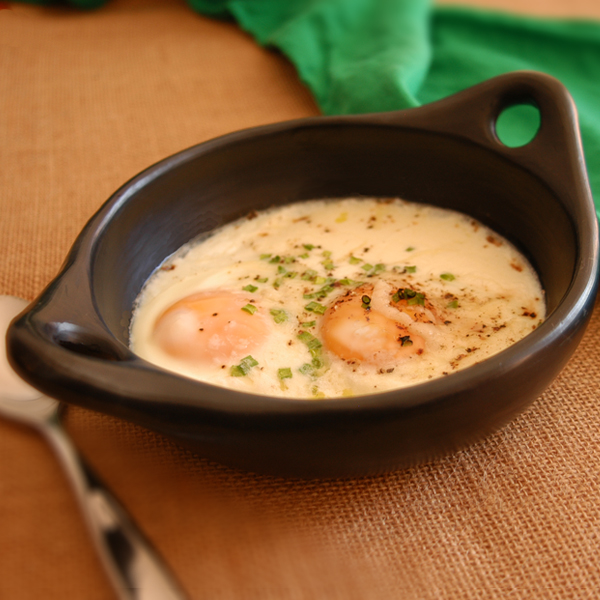Black Clay, La Chamba Round Serving Dish w/Lid
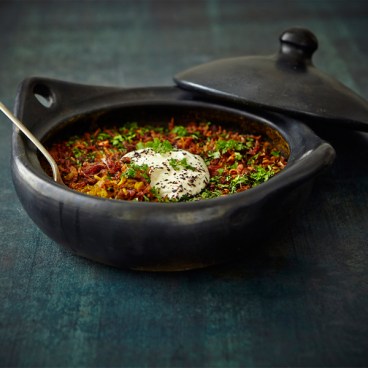
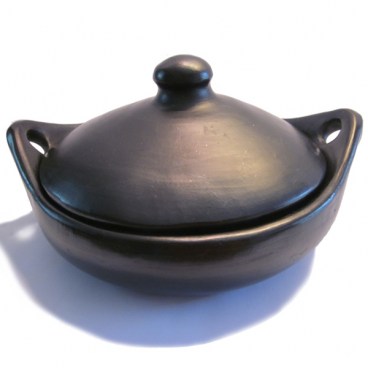
Description
About the piece
Care and Use
Curing
How they are Made
Recipes
Related Products
Reviews
Monday, 05 September 2016
This can be used for cooking as any of the La Chambra pieces. The lid fits just right in one position and lets a bit of steam out in other positions. It is a beautiful handmade item. I was a bit surprised that the clay itself is not black, rather the type of firing blackens the clay. There were traces of charcoal on the first cleaning.Judy T.
Saturday, 09 August 2014
Great product.Majda Behani
Tuesday, 24 June 2014
I`ve had other LaChamba cook/bake/serve ware for several years and decided to replace some of my metal pots and pans with LaChamba. It cooks evenly and the food tastes great. Be careful to let it heat slowly...I cracked one of my old pots by putting it on a hot burner. Ancient Cookware is a fabulous company with fantastic customer service and their prices are good...even with the shipping costs...and I do not say things like that lightly.Laynie
Friday, 21 February 2014
Great product, received in two days. Love this type cookware. We have replaced a lot of our dishware and cookware with this type of cookware. If you like a natural feel and better taste better cooking and keeping things warm long after cooked you will love this.Robert




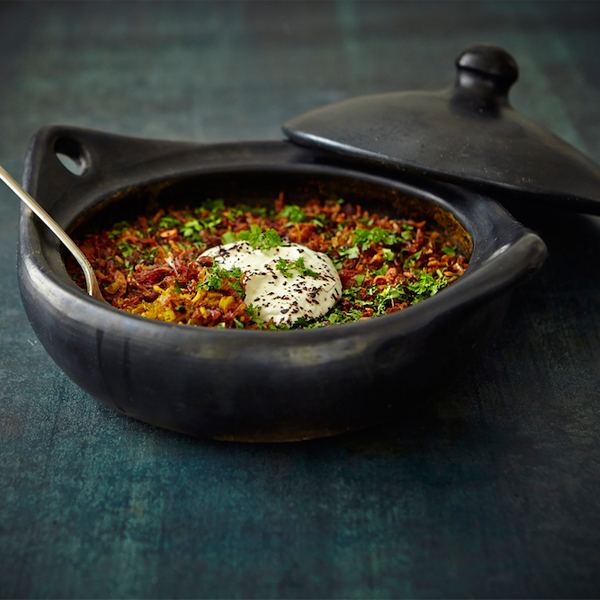


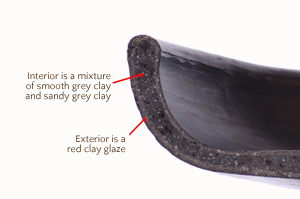 Three different types of clays from local mines are used in the making of these ceramics. They are dissolved in water and strained to remove little stones and other impurities. The interior of the ceramics are made with a mixture of a smooth, grey clay that gives the piece its strength and body, and a sandy grey clay that makes it easier to mold. The exterior is then “glazed” with a watery red clay which gives the piece a smooth surface, and allows for the polishing.
Three different types of clays from local mines are used in the making of these ceramics. They are dissolved in water and strained to remove little stones and other impurities. The interior of the ceramics are made with a mixture of a smooth, grey clay that gives the piece its strength and body, and a sandy grey clay that makes it easier to mold. The exterior is then “glazed” with a watery red clay which gives the piece a smooth surface, and allows for the polishing.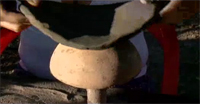 The process begins by flattening a ball of clay and forming it around a mold specifically made for each model. This “shell” is then smoothed and trimmed using tools fashioned from bamboo and plastic pieces.
The process begins by flattening a ball of clay and forming it around a mold specifically made for each model. This “shell” is then smoothed and trimmed using tools fashioned from bamboo and plastic pieces. 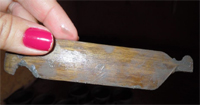 The pieces are then left to air dry, receiving a light polishing during the drying to make sure they have a smooth surface and free of sand. The pieces are then transported to other artisans that specialize in adding rims and/or handles. The handing off progression continues with other artisans which specialize in the production of the lids, which are custom
The pieces are then left to air dry, receiving a light polishing during the drying to make sure they have a smooth surface and free of sand. The pieces are then transported to other artisans that specialize in adding rims and/or handles. The handing off progression continues with other artisans which specialize in the production of the lids, which are custom 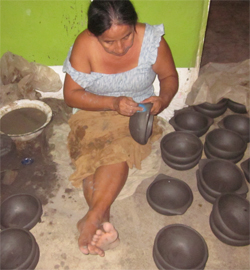 made for each piece. Even the knobs on the lids are made by artisans who specialize in only adding knobs to lids.
made for each piece. Even the knobs on the lids are made by artisans who specialize in only adding knobs to lids.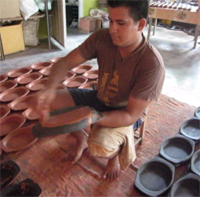 After each step the pieces are laid out to dry in the scorching La Chamba sun. Sometimes the process is delayed due to rains which prevent the drying of the pieces. When it begins to rain, the entire community is mobilized to quickly cover drying pieces that were outside in various production stages. The pieces are then lightly polished with a soft sponge to ensure a smooth exterior, and they are then taken to artisans that glaze each piece with the watery red clay. The glaze is not let to dry completely to allow for the next step of polishing, which is probably the most laborious part of the process, the polishing.
After each step the pieces are laid out to dry in the scorching La Chamba sun. Sometimes the process is delayed due to rains which prevent the drying of the pieces. When it begins to rain, the entire community is mobilized to quickly cover drying pieces that were outside in various production stages. The pieces are then lightly polished with a soft sponge to ensure a smooth exterior, and they are then taken to artisans that glaze each piece with the watery red clay. The glaze is not let to dry completely to allow for the next step of polishing, which is probably the most laborious part of the process, the polishing.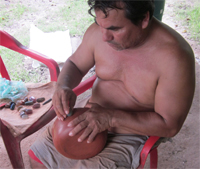 The hand polish, a process known as burnishing, is done by rubbing the entire piece with semiprecious stones until it has a uniform brightness on the surface. Depending on the size of a piece, the polishing can take up to half an hour to an hour. Originally, this polishing was done with smooth river rocks
The hand polish, a process known as burnishing, is done by rubbing the entire piece with semiprecious stones until it has a uniform brightness on the surface. Depending on the size of a piece, the polishing can take up to half an hour to an hour. Originally, this polishing was done with smooth river rocks 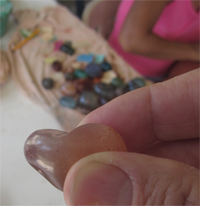 from the bottom of the Magdalena River, but is now done with agate stones brought from Brazil which are stronger. With use, the stones grind down even creating grooves from corners and edges.
from the bottom of the Magdalena River, but is now done with agate stones brought from Brazil which are stronger. With use, the stones grind down even creating grooves from corners and edges.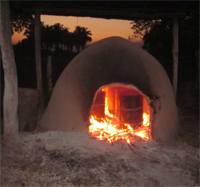 To start the firing process, the pieces are placed inside metal drums, with smaller objects first going inside larger earthenware pieces. These metal drums are then placed in wood burning ovens, usually late in the day so as to minimize the heat to the workers. The firing process takes approximately three hours, with the furnace reaching approximately 750°C. This high heat, together with the glazing and burnishing process, result in utilitarian pieces strong enough to withstand rough treatments and make them ovenproof.
To start the firing process, the pieces are placed inside metal drums, with smaller objects first going inside larger earthenware pieces. These metal drums are then placed in wood burning ovens, usually late in the day so as to minimize the heat to the workers. The firing process takes approximately three hours, with the furnace reaching approximately 750°C. This high heat, together with the glazing and burnishing process, result in utilitarian pieces strong enough to withstand rough treatments and make them ovenproof.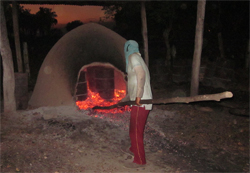 After the firing comes probably the most interesting part of the entire process and is what gives the pieces their unique black color. The metal drums are pulled out of the ovens with the help of long sticks.
After the firing comes probably the most interesting part of the entire process and is what gives the pieces their unique black color. The metal drums are pulled out of the ovens with the help of long sticks.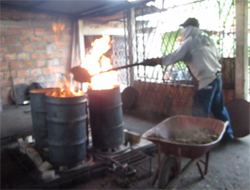 The drums are then covered to extinguish the flames but keep the material smoking vigorously for quite some time. The smoke penetrates the pieces giving each piece the black color that so characterizes products from La Chamba.
The drums are then covered to extinguish the flames but keep the material smoking vigorously for quite some time. The smoke penetrates the pieces giving each piece the black color that so characterizes products from La Chamba.